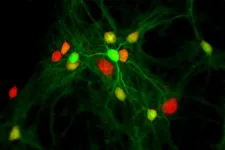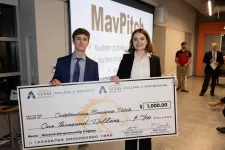(Press-News.org)
Epilepsy is a brain disorder that causes recurring seizures.
It is one of the most common neurological diseases, and it affects approximately 50 million people worldwide, according to the World Health Organization. In 2023, nearly 450,000 children in the United States were diagnosed with the disease.
Virginia Tech researchers at the Fralin Biomedical Research Institute at VTC are exploring how gene variants identified in children with severe epilepsy can have an impact on neurons, leading to abnormal electrical activity in the brain and recurrent seizures.
With two recent grants totaling $2.4 million from the National Institute of Neurological Disorders and Stroke at the National Institutes of Health, scientists led by Matthew Weston will use mouse models expressing these epilepsy-associated gene variants to understand how they alter neuron behavior to cause seizures.
The Weston lab is particularly interested in a gene called KCNT1. This specific segment of DNA carries the instructions for a protein that forms an ion channel that acts like a tiny gate embedded in the membrane of neurons to control the flow of potassium ions.
This flow is essential to help neurons communicate properly and regulate the electrical activity in our brain, according to Weston, an associate professor at the Fralin Biomedical Research Institute.
Changes in this gene affect normal nervous system function and can lead to seizures by causing a dysregulation of electrical stabilization in neurons that can spread across networks throughout regions of the brain. Earlier investigations by Weston’s team examined the influence of KCNT1 genetic abnormalities on the excitability of neurons, indicating their potential connection to epilepsy.
"We’re using mouse models with the exact same KCNT1 mutations that cause severe and untreatable epilepsy in kids,” said Weston, who is also an associate professor in Virginia Tech’s School of Neuroscience in the College of Science. “By closely examining these models, we hope to discover a path to therapeutic intervention.”
Weston is collaborating with Wayne Frankel, professor of Genetics and Development at Columbia University’s Institute for Genomic Medicine. Frankel recently designed new research models for this study: a model with the KCNT1 genetic mutation in all neurons and another model that allows the KCNT1 genetic mutation to be expressed only in a subpopulation of neurons to identify which neuron types are most important for the disease.
By looking at the neurons in the brains of these models, Weston aims to uncover fresh perspectives on the alterations in neuronal function induced by KCNT1 mutations, resulting in heightened excitability and seizure occurrence. More importantly, he hopes to pinpoint the neuron types most susceptible to these changes, potentially guiding the development of innovative treatment strategies.
“With these models, we’re hoping to find new mechanisms underlying the disease and point to new therapies,” Weston said.
Weston serves on the scientific advisory board for the KCNT1 Epilepsy Foundation, which supports research and drug development, with the ultimate goal of finding an eventual cure for KCNT1-related epilepsies.
Amy Shore, a research scientist in Weston’s lab, finds inspiration in the connection with the foundation.
“Engaging with parents, and hearing stories about the devastation of this disease on their children and their daily lives, motivates us to focus and do our best to find answers that can translate into hope,” she said.
END
University of North Carolina at Chapel Hill researchers have discovered that tardigrades – microscopic animals famed for surviving harsh extremes – have an unusual response to radiation.
Led by UNC-Chapel Hill researcher Bob Goldstein’s lab, the new research paper published on April 12 in Current Biology reveals new details on tardigrades’ responses to radiation. Radiation has long been known to damage DNA, and in humans, DNA damage from excessive radiation exposure can lead to diseases. But the tardigrades have an unexpected way to correct the damage.
“What we saw surprised us,” said Goldstein. “The ...
Universities are engines for economic growth that today are supporting technology development, innovation and economic advancement as never before.
With the launch of its Center for Entrepreneurship and Technology Development (CETD), The University of Texas at Arlington is beginning a new era of support for student and faculty entrepreneurship. The center, whose mandate also includes supporting the region’s vibrant innovation economy, will expand UTA’s engagement with public and private partners everywhere.
“CETD fosters a vibrant and supportive atmosphere ...
NEW ORLEANS, La – Ochsner Health is the recipient of the 2024 Top Workplaces Culture Excellence awards in four distinguished categories: Innovation, Work-Life Flexibility, Leadership and Purposes & Values. These accolades are administered by Energage, a purpose-driven organization that develops solutions to build and brand Top Workplaces.
The Top Workplaces program has a 17-year history of surveying and celebrating people-first organizations nationally and across 60 regional markets. Top Workplaces awards are based on feedback from a research-backed employee engagement survey.
“It is an honor to receive ...
Scientists have long wondered how the eye’s three cone photoreceptor types work together to allow humans to perceive color. In a new study in the Journal of Neuroscience, researchers at the University of Rochester used adaptive optics to identify rare retinal ganglion cells (RGCs) that could help fill in the gaps in existing theories of color perception.
The retina has three types of cones to detect color that are sensitive to either short, medium, or long wavelengths of light. Retinal ganglion cells transmit input from these cones to the central nervous system.
In the 1980s, David Williams, the William G. Allyn Professor of Medical Optics, ...
Embargoed for release until 5:00 p.m. ET on Monday 15 April 2024
Annals of Internal Medicine Tip Sheet
@Annalsofim
Below please find summaries of new articles that will be published in the next issue of Annals of Internal Medicine. The summaries are not intended to substitute for the full articles as a source of information. This information is under strict embargo and by taking it into possession, media representatives are committing to the terms of the embargo not only on their own behalf, but also on behalf ...
NORMAN, OKLA. – University of Oklahoma engineering researcher Sangpil Yoon, Ph.D., has been awarded a $2.3 million grant from the U.S. Department of Health and Human Services, National Institutes of Health, for his project titled “Development of protein-based nanostructures activated by ultrasound.”
The five-year grant is part of the NIH’s Research Project Grant (R01) program, which supports cutting-edge health-related research and development initiatives. Yoon’s funding, totaling $363,919 for ...
As sea levels rise, coastal groundwater is lifted closer to the ground surface while also becoming saltier and more corrosive. A recent study by earth scientists at the University of Hawai‘i (UH) at Mānoa compiled research from experts worldwide showing that in cities where there are complex networks of buried and partially buried infrastructure, interaction with this shallower and saltier groundwater exacerbates corrosion and failure of critical systems such as sewer lines, roadways, and building foundations.
“While it has been recognized that shallowing groundwater will eventually result in chronic flooding as it surfaces, ...
As one of the first health systems in the country to pilot the use of generative artificial intelligence (GenAI) to draft replies to patient messages inside the Epic Systems electronic health record, UC San Diego Health is a pioneer in shaping the future of digital health.
The results of a new University of California San Diego School of Medicine study indicate that, although AI-generated replies did not reduce physician response time, they have contributed to relieving cognitive burden by starting an empathetic draft, which physicians can edit rather than starting from scratch.
The study, published in the April 15, 2024 online edition of the Journal of ...
PHILADELPHIA— Mitchell A. Lazar, M.D., Ph.D., the Rhoda and Willard Ware Professor in Diabetes and Metabolic Disease, and Director of the Institute for Diabetes, Obesity, and Metabolism in the Perelman School of Medicine at the University of Pennsylvania, is the 2025 recipient of the George M. Kober Medal from the Association of American Physicians (AAP). Lazar will receive the honor in Chicago at the AAP’s annual meeting which takes place April 25-27, 2025.
The AAP, an elected society of the nation’s most distinguished physician scientists, was founded in 1885 by seven physicians, including Sir William ...
DALLAS (SMU) – The challenge is to connect the dots for high school students between the technology in their cell phones and the career options manufacturing the devices. To that end, the National Science Foundation (NSF) has awarded an Innovative Technology Experiences for Students and Teachers (ITEST) grant to SMU professor Lin Lipsmeyer and colleagues toward developing one of the first game-based semiconductor curricula for high school students.
The online game-based semiconductor curriculum will be made available to a wide range of students through a collaboration with Dallas-based gaming company Stimuli. Additional ...




